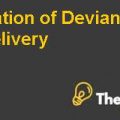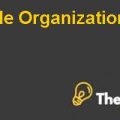Amazonite Enterprises Case Study Solution
Analytical Review:
Cash of the company has increased by 5.63% which is a good increase compared to its previous year as the company will not experience any liquidity problems if the cash continues to grow in future as well but the cash might have been acquired by illegal means such as money laundering therefore it is consider as significant account. However, the accounts receivable has also increased by 18.66% and this shows that the company’s cash is stuck in accounts receivable and the accounts receivables are being recovered slowly. In addition to this the inventory has also increased by 17.82% and this will lead to the working capital cycle being increased in terms of days as the inventory and accounts receivables will take time to be converted into cash. There is a risk that there might have been some fictitious customers in accounts receivables and the inventory recorded might have become outdated or obsolete.
The sales of the company have increased by 30.03% whereas the cost of sales have only increased by 2.78%, this can be the deliberate efforts of the management to make the company more financially attractive. On the other hand, the other income has increased by almost 95.2% and this is a huge increase which needs to be investigated. In addition to this, the depreciation costs have increased by 123.35% which is quite high in comparison to the previous year.
Selection of accounts:
The seven accounts that have chosen from the trial balance of Amazonite Enterprise are cash at bank, accounts receivables, inventories, sales, and cost of sales, Depreciation and wages. See Exhibit 1
Materiality:
Auditor sets the materiality by benchmarking certain accounts balances. Normally they benchmark PBIT or sales revenue for income statement and total or non-current assets for balance sheet. Amount of income statement above the 10% of PBIT or 2% of sales revenue is considered as material and amount more than 5% of Total assets is consider as material for balance sheet. While the amount lower than 5% of PBIT, 1% of sales revenue and 2% of Total assets is considered as immaterial. Auditor use judgmental approach to determine the materiality of account balances which are in between of these benchmarks. (evidence, 2016)
We use PBIT as benchmark for income statement items and total assets for balance sheet items. See Exhibit 2
Cash at bank:
Analytical review:
The cash balance at bank of Amazonite have been increased by almost 5.63%, as cash is a liquid asset therefore the risk of theft is high in this account balance. Due to the inherent risky nature of cashthe sensitivity of this account has been increased therefore auditor should investigate this account more carefully.(audit, 2016)
Rational for selection:
The cash account is above the materiality threshold. Furthermore, cash has inherent risk as explained above therefore selected for further audit testing. Moreover, there will be very adverse consequences of misstatement in this account as many fraudulent activities can beconduct using this account like theft, money laundering and etc.
Amazonite Enterprises Harvard Case Solution & Analysis
Assertion:
The assertion of completeness appears to be reasonable for the cash balance at bank. This assertion states that the all transactions that should have to record in the financial statements are recorded by the management and the cash balance should not have to be over or understated.(assessment, 2016)
Audit Procedures:
- Obtain direct conformation from bank regarding the account balance to ensure that all the transactions have been recorded.
- Review the list of transactions and compare them to the bank statement to ensure the completeness of the cash balance.
Accounts receivable:
Analytical review:
There is a high increment in the accounts receivables as compare to the previous year, they have been increased by almost 18.66%. Although there are many legitimate reasons for the increase in accounts receivables such as increase in sales and change in company’s policy. However, some large discrepancies have occurred in the accounts receivables in many companies and there are many complexities involved regarding the calculation of bad debts which makes this account complex and risky thus, further testing needs to be performed.
Rational for selection:
The accounts receivable balance requires many assumptions and judgements from management regarding the bad debts estimates. The management can alter the assumptions and judgements depending on the needs to improve the financial results of the company. Thus, the risk of material misstatement is very high in this regard.
Assertion:
The relevant assertion for the accounts receivable account is rights and obligations, according to this assertion all the assets relating to the entity should be recorded and the entity should have the right to collect that amount.
Audit Procedure:
- Obtain receivable journal ledger and compare the amount of each debtor against the individual debtor ledger to ensure that receivables are recorded at their correct amount and they belong to the entity....................
This is just a sample partial case solution. Please place the order on the website to order your own originally done case solution.













